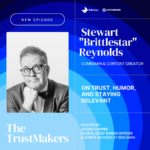By Jim Meskauskas, Chief Strategy Officer, Media Darwin
Nearly 30 years ago, I began my career in digital media. I designed campaigns and bought and sold inventory on sites such as Windows Media (Microsoft), xCite, Blastro music videos, and local TV stations that no longer exist. The open internet was a reality, and seeing so many wonderful producers build a new industry was exciting.
These past 10 years have destroyed that promise.
Last month, during the IAB Leadership Summit, the conference that gathers the internet’s leading publishers, David Cohen, the IAB’s CEO, urged the audience in his keynote address to “Save the Open Internet” in a desperate plea that he had repeated several times during past years’ events.
But the Open Internet is already dead.
Google, The Trade Desk, and a few dominant players have consolidated power, creating a closed ecosystem in which they control pricing, data, and distribution, effectively shutting out independent publishers. It isn’t that there haven’t always been dominant players that have been the receptacles of most advertisers’ spending. However, these current industry oligarchs have created a “data mirage,” with false positives and billions in advertising waste in the last decade. The growing issue they have been tamping down for years reeks of unreliable advertising data, where AI-driven optimization leads to false positives, misattributed engagement, and wasted ad dollars that benefit the platforms but not the advertisers.
These players, especially The Trade Desk, have also created a dark economy of made-for-advertising (MFA) sites. This is how billions of ad dollars are funneled into low-quality content farms, fueling fraud and undermining legitimate journalism and content creation.
Who’s Watching the Watchmen?
The Lack of Oversight in Digital Advertising – How the self-regulation of tech giants has resulted in unchecked fraud, lack of transparency, and an environment where bad actors flourish while regulators struggle to keep pace. Think the recent Analytics Study would stir up some controversy? Think again. It was met with a collective yawn. Nothing to see here, keep moving.
The Illusion of Connected TV as a Solution
While CTV is often framed as the next frontier, in its current state, it is already plagued by many of the same issues – fraud, opaque supply chains, and concentrated control – raising concerns that history is repeating itself.
Certainly, all of these can be connected through allusion to a central thesis. The digital advertising industry, once founded on the promise of an open and transparent internet, has instead deteriorated into a murky, fraud-ridden system dominated by a few major players—Google, The Trade Desk, and other ad-tech giants—who exploit their power to redirect revenue, manipulate data, and facilitate cartel-like behavior to the detriment of independent publishers, advertisers, and content creators.
But more than that, the ecosystem in which all of this has been fomented is to blame. There is now and never has been incentive in the value chain to make it right. Marketers get to show procurement that they’re keeping unit costs low; agencies get to show their clients low unit costs; publishers realize some revenue from the marketplace for inventory that may yield none, and tech providers get to make money both coming and going. However, the efficiencies are illusory, the data gathered is dirty, and the decisioning based on that data is faulty, so real improvement in advertising’s efficacy remains out of reach.
Big Numbers Behind A Big Lie
According to the Association of National Advertisers 2023 Supply Chain Study, there was $22 billion worth of MFAs across Digital Advertising. Worse, the latest eMarketer report suggested that there is as much as $84 billion, citing Juniper Research. That $22-84 billion is directly at the expense of the Open Internet’s publisher community. That money deprives the industry’s content creators and is the main reason the Open Internet is dead.
Are there ANY White Hats?
The Adalytics study laid bare what a fraud the so-called “verification” segment has become. DoubleVerify, IAS and the company formerly known as White Opps (Human) generate millions in fees every day while adding little value to the ecosystem. So, what can a smart buyer do? Who are the good guys wearing the white hats?
Look at two OGs who have been around since the beginning, solving problems like this. Long after he enabled privacy and brand protection by design at Real Media in the ‘90s, Dave Morgan started and sold Tacoda to help buyers and sellers with behavioral campaigns. He then launched Simulmedia to help buyers navigate the immensely complicated CTV space, even before CTV was a $100 million market.
Similarly, in the ‘90s, Matt Wasserlauf started and sold Torrential and BBE to solve ad serving problems in digital video before launching Blockboard in 2018 to solve the fraud problem for buyers and sellers.
Wasserlauf was the first person to convince me that the future of digital was to be found in video at a time when I thought, who the heck wants to watch video on a computer screen, let alone a mobile device? His concern then, as it is now, was how to ensure a good user experience while at the same time avoiding the sins of display by making sure there were actual faces behind the “eyeballs” being counted.
Blockboard’s tech makes verification tools moot by pre-verifying all inventory on every impression with its blockchain-enabled AI, which then provides comprehensive impression and call logs on each campaign flight.
Is your video ad partner providing comprehensive campaign logs? Trade Desk and Google don’t do this, which amazes me. Why don’t buyers demand full transparency in real-time?











